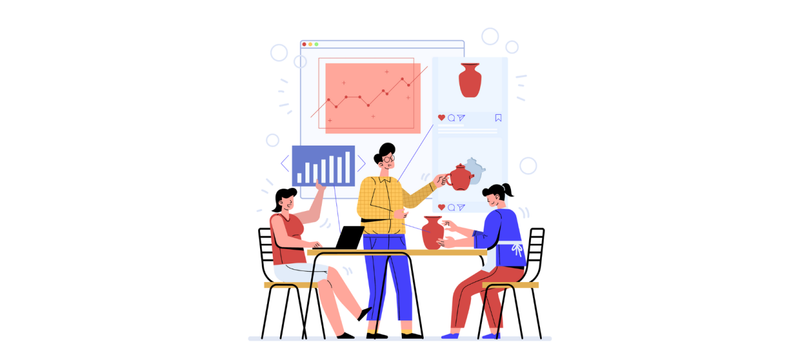There are many methods of selling products online, but there are few as powerful as upselling and cross-selling. With the right marketing plan in place, these sales strategies can lead to added sales and revenue for your company, and can actually add benefits to your customers.
Before we get started examining the benefits of upselling and cross-selling for your organization, let’s define the meaning of each.
Upselling increases the profit by offering a similar product of a higher quality. Let’s use cars as an example. For one specific type of vehicle there are many different models, each with their own premium upgrades. Those upgrades are set at a higher price tier.
As you explore the car’s options, you may purchase higher quality wheels, a sunroof, and even heated seats. These higher premiums wouldn’t be available with the lowest-tiered model, and would be expensive to install after-market.
Cross-selling increases profit by augmenting the number of objects sold. Let’s return to the car example. In most cases, it would be difficult to sell an average person another car right after buying one. However, if a customer were to buy a car for trekking into the forest on the weekends, they might buy a mounted storage rack. If the customer were a cyclist, they might purchase a bike rack for the rear of their car.
If the dealership had a great understanding of their customer personas, they would see that their customers’ needs aren’t always met with just the sale of the car, but how add-ons can enrich the life of the customer now that they have a vehicle.
Let’s take a look at some of the benefits of upselling and cross-selling below.
5 Surprising Benefits of Upselling and Cross-Selling
1. Increased Profits
When a customer buys more, or buys a more expensive product, your company gains an increase in profits. But it’s not enough to just retain customers! You must also actively seek ways to gain more of a share of your customers’ spending habits. By upselling or cross-selling you can address what needs your customers might be looking to fill elsewhere, and offer items to gain more of their spend.
2. Increased Loyalty
While some people may think that upselling doesn’t always match customers’ needs, there is no harm in presenting options. Upselling provides customers with everything necessary for them to make the correct choice. With upselling, you show customers that you think ahead and consider all of their possible needs.
Similarly, with cross-selling you are offering additional products and services that are complementary to the purchased goods. If you’re able to provide something that enriches your product for the benefit of the customer, you’ll see more repeat purchases and referrals.
Customers develop loyalty for companies that look out for their well-being. Anything a company can do at the beginning of the purchase cycle to increase loyalty will minimize any customer losses later on.
3. Increased ROI
Finding new customers can be costly. Once a prospect converts into a customer, do you really want to leave money on the table? Upselling and cross-selling allow you to see more return-on-investment, as your customers are spending more once they come across your site. To truly make the most of upselling and cross-selling, offer customers products that are as relevant as possible.
4. Balanced Growth
In any business, customer retention increases profits. You must always be considering how to manage finding new customers, and balancing active or customers who have already purchased.
Upselling and cross-selling are strategies that work significantly well for customers who are currently purchasing, but do not forget to stretch these strategies out to your already existing customers as well, through offering relevant and helpful products related to their past purchases.
5. Convenience and Flexibility
For every benefit that upselling and cross-selling provides businesses, there are just as many for customers. If a customer has an already-established relationship with a company, chances are they do not want to shop around to find a product, and would rather purchase from an institution they trust, if that company only offered that product.
Upselling and cross-selling open up a wide array of convenience for customers as they lower their risk of purchase-related dissatisfaction, and can buy more items that they find necessary in one location.
Now that you’ve discovered the benefits of both for businesses and customers, it’s worth taking a look at how to get started with upselling and cross-selling with your business.
How to Implement Upselling and Cross-Selling in E-commerce
As there are many different companies and organizations serving customers with different needs, there is no one-size-fits-all approach to integrating upselling and cross-selling into your business. However, there are some suggestions that we’ve seen work for many online stores. Let’s take a deeper dive into these strategies below.
In e-commerce, upsells are generally upgrades to a specific product, while cross-sells motivate customers to buy additional products that complement their purchase. Here are some takeaways that work well for both cross-selling and upselling.
Complement Your Sales
Products that complement what your customers have already purchased is a common method for upselling and cross-selling. If your product is relevant enough, or the upgrades make sense for the customer, they’ll see the value in the purchase and will convert.
Make sure you are using a relevant and robust recommendation engine, as customers can react negatively to seeing products recommended to them that they otherwise would not want.
Learn more about positive product recommendations.
Discount Your Products
Discount coupon codes are a great way to upsell and cross-sell. These discounts can be applied either during checkout for some additional merchandise or to a customers’ next purchase. Make sure when sharing the discount code that you show which products the discount applies to.
Learn more about creating amazing promotions.
Free Gifts and Samples
If your customers do decide to purchase an upgraded premium or broaden their purchasing horizons, you could offer a free gift to them for purchase the upsell or cross-sell. Customers feel delighted when they receive something free, and can often be a decision maker if the free item is properly targeted to the audience.
Similarly, if your customers are purchasing products or have looked at products, you can use this data to determine which free samples you might want to provide them with. By doing this, you help to incentivize conversions and actually raise awareness for other products that they may like or just haven’t considered yet.
As with anything, you’ll need a combination of testing and data to see if your cross-selling and upselling strategies are working for you. However, if they are, the sales will speak for themselves and you’ll see higher profits, happier customers, and an overall healthier business model.
Don’t just take our word for it! Get out and start selling today.





